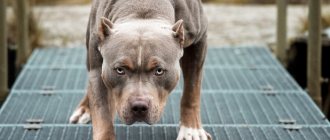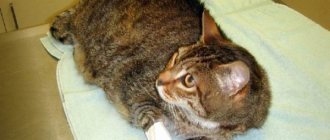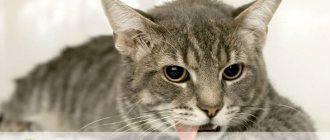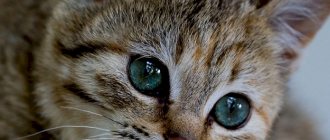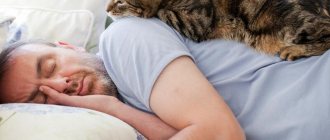11057Administration
2
Sometimes an owner is faced with the fact that his beloved cat is limping on his hind leg. There are many reasons for this phenomenon, and it is important to determine exactly what caused the lameness. A sick animal tries not to put any strain on its paw, almost never steps on it, and falls heavily when walking. The cat stops running, climbing trees, jumping through cabinets because it experiences pain and discomfort when moving and putting stress on the affected limb. It is necessary that the treatment is carried out correctly and the disease does not become chronic. If, in addition to lameness, the owner notices that bald spots are forming between the hind legs, contacting a veterinarian should be urgent. In some cases, lameness is an indicator of an emergency condition.
Sometimes an owner is faced with the fact that his beloved cat is limping on his hind leg. There are many reasons for this phenomenon, and it is important to determine exactly what caused the lameness. A sick animal tries not to put any strain on its paw, almost never steps on it, and falls heavily when walking. The cat stops running, climbing trees, jumping through cabinets because it experiences pain and discomfort when moving and putting stress on the affected limb. It is necessary that the treatment is carried out correctly and the disease does not become chronic. If, in addition to lameness, the owner notices that bald spots are forming between the hind legs, contacting a veterinarian should be urgent. In some cases, lameness is an indicator of an emergency condition.
© shutterstock
Trauma is the most common cause of lameness in cats.
Cats are by nature very active and curious. These qualities often play a cruel joke on them. While examining unfamiliar objects, they can receive various injuries: open injuries to the skin and soft tissues, dislocations, sprains and torn ligaments, bone fractures and joint injuries. If your four-legged pet suddenly becomes lame, the cause of the lameness probably lies in one of the listed problems.
Soft tissue damage
Fights with relatives and contact with sharp objects can lead to damage to soft tissues. This condition, in addition to lameness, is accompanied by bleeding of varying degrees of intensity, redness of surrounding tissues, and acute pain. Traumatic swelling often occurs, which over time turns into purulent inflammation. The appearance of pus poses the greatest danger.
If the wound is deep and extensive, surgery is required. Injuries received within a few hours before contacting a veterinarian are disinfected and closed with a blind suture. If more time has passed since the injury or there are signs of wound infection, treatment includes the use of antibacterial, anti-inflammatory and analgesic veterinary medications.
If you notice that your pet is pressing its front or back paw, you need to examine it. If there is a wound, it should be treated with any available antiseptic and try to stop the bleeding yourself, and then take the animal to the veterinary clinic.
Dislocations, sprains and ligament tears
Cats group well when jumping, trying to land on their paws. However, they are not always able to group correctly, and if the landing is unsuccessful, dislocation or damage to the ligaments is possible. These are rare injuries for felines, but their possibility cannot be completely ruled out. Information about them is presented in the table:
Degrees_ that a paw bruise can take in a kitten or an adult cat
Mechanical damage to the limb such as a bruised paw in cats is divided into four degrees:
11th degree. A characteristic feature of bruises is damage to the inner layers of the skin and subcutaneous tissue. A bruise may be accompanied by the formation of a shallow wound such as an abrasion or scratch. Swelling of the injury site and pain are likely. The pain is mild and may be completely absent. Upon examination, you can notice signs of burst blood vessels on the surface of the animal’s skin. A first degree bruise is characterized by rapid healing and does not require complex treatment. Often, with a first-degree bruise, the cat does not limp. 22nd degree. Bruises of this type are accompanied by the formation of hematomas, separation and rupture of muscles. A common sign of injury is swelling caused by the inflammatory process. The animal has an elevated temperature, increased heart rate and breathing, and the cat limps for a long time. 33rd degree. Such bruises pose a real threat not only to the health, but also to the life of the cat. Third degree damage is accompanied by a change in the appearance of the skin. The concept of bruise in this case means damage to muscle tissue, tendons, the formation of fractures and cracks in bones. Along with a 3rd degree bruise, joint dislocation is often noted. When bruised, the animal experiences shock. In the absence of qualified assistance during the first day from the moment of injury, there is a risk of developing tissue necrosis. 44 degree. Mechanical damage to the limbs of the 4th degree is the most dangerous for a cat. Injuries of this complexity are accompanied by crushing of bones and crushing of tissues. Through external damage to the skin, infection enters the animal’s body. Thus, inflammatory and purulent-putrefactive processes occur. The consequence of injury is often an abscess, sepsis and associated negative processes.
Do not neglect qualified veterinary care to avoid potentially dangerous consequences. A kitten's paw bruise is an injury that requires timely attention.
How to detect a bruised paw in kittens and cats?
- The following indicate a bruised paw in a kitten or cat: symptoms:
- The appearance of swelling on the animal's paw. Swelling of the injury site is caused by internal bleeding. While the skin remains intact, blood accumulates inside, causing a characteristic swelling.
- Restless behavior of a pet. When a cat receives a mechanical injury, it feels discomfort and its behavior differs from usual. The pet looks for a “closed” place and hides from the owner, presses its injured paw, does not step on it, and often licks the limb.
- Lameness when walking. In most cases, the cat will noticeably limp due to an injured paw.
- The appearance of external signs of damage. A hematoma, bruise, or lymphatic extravasation is likely to be detected in the area of injury. These signs occur against the background of compression and shaking of internal tissues. There may be an abrasion noticeable to the naked eye, swelling due to inflammation.
In some cases, paw bruises affect internal organs
, osseous-ligamentous apparatus, which provokes the appearance of other symptoms. If you notice that the cat reacts painfully to touching the damaged paw, squeals, or “defends itself” - this is a sufficient reason to contact a veterinarian.
What to do to provide first aid when a kitten has a bruised paw?
“Street” animals accustomed to “wild” conditions can cope with minor bruises on their own
. From this point of view, pets require more involvement from the owner. Even if we are talking about a bruise of the first and second degree, first aid before the arrival of a veterinarian is necessary
.
If the bruise is accompanied by bleeding , try to stop the bleeding and treat the wound. This way you will prevent infection. Be sure to wash your hands. Use gauze pads or a bandage to stop bleeding. The use of cotton wool is not recommended, as particles of the material remain in the wound and cause clogging.
If the bleeding is profuse , it is necessary to apply a special tourniquet or use improvised means. Wrap the material tightly around the edge of the damaged vessel or pinch it with your finger wrapped in a handkerchief. Hold your finger on the wound until a blood clot appears, blocking the bleeding. The artery on the hind leg is pinched from the inside of the thigh, and on the front leg – “above the elbow”.
Be sure to treat the wound to prevent infection. Any disinfectant composition is suitable for this, including hydrogen peroxide or brilliant green. After stopping the bleeding and treating the wound, fix the paw and provide the animal with rest.
These actions are enough to provide first aid to the animal. Next, the owner should immediately contact our veterinary center. Our veterinarians will undertake the diagnosis and determine further treatment to avoid the negative consequences of the bruise.
Joint diseases
The cat is limping on its front leg without visible damage
Also, without visible damage, the cat limps on its hind leg with serious joint diseases. Some of them are congenital and therefore develop slowly. Pathology cannot be detected by a simple examination without medical education. If you pay attention to the accompanying symptoms and promptly contact specialists, the animal can be cured without resorting to surgery.
- Hip dysplasia is a genetic disease. It is dangerous because it can progress even in young cats. Lameness is especially noticeable after prolonged rest (sleep, rest).
- Arthritis and arthrosis are common in older animals. The disease affects bone tissue, causing pathological changes. Due to pain, cats try to move as little as possible, preferring to lie down. They often refuse food and become weak. When palpating swollen joints, they react sharply to pain. The disease may be accompanied by fever.
- Patella patellar luxation, or patellar luxation, is an uncommon problem in cats. It is usually the result of severe trauma, or less commonly a genetic abnormality. It occurs suddenly, causing severe pain in the animal. At the slightest movement of its paw, the cat meows loudly. The injury requires immediate treatment, and in advanced cases, surgery.
Lack of calcium affects the motor functions of kittens
- Osteomyelitis is a disease that occurs in young cats during the phase of active growth and development. Degeneration and partial destruction of bone tissue can affect not only one limb, but all at once. The disease is characterized by acute pain in the pet, which is why even light touches cause aggressive behavior.
- Osteochondrosis, in which pinching and compression of the nerve roots in the spine occurs, causes the animal to limp in any of the four limbs. Wear of the cartilage layer of the intervertebral discs affects the cat’s ability to move easily.
- Osteosarcoma is a malignant neoplasm. Usually it is a pathology of older cats that have crossed the 6-7 year mark.
All of these diseases can only be diagnosed by a doctor at a specialized clinic. They require mandatory treatment with corticosteroids, immunostimulating and painkillers under the supervision of a veterinarian. In severe cases - surgical intervention.
Important! If there is any suspicion of joint disease in cats, you must immediately take your pet to the clinic. Delay or attempts at treatment at home can negatively affect his health and lead to death.
Why does the animal limp, although there are no visible injuries or obvious causes?
Sometimes it happens that a cat limps from time to time, but there are no visible signs, as well as obvious causes of lameness. In this situation, only a veterinarian can understand why the pet began to limp on the front or back leg. This may be due to diseases of the joints, bone tissue, neoplasms, problems with the spine, and the consequences of infections.
The cat sometimes doesn't step on its paw
Problems such as feline osteoarthritis may explain why a cat limps periodically. In fact, rather than limping, we will observe a strange wandering with stiff limbs, especially when the cat stands up after a period of rest. After walking for a while, he appears to be able to walk normally, which confuses his caregivers.
When problems with osteoarthritis occur, other symptoms appear that may go unnoticed, or we attribute them to the age of the animal, since they are more common in older cats. We insist that it is difficult to assess a cat's pain, but we may notice that she eats less, spends most of her time resting away from her family, avoids jumping, loses muscle mass, stops using the litter box, or does so without grooming herself. .
Treatment is pharmacological and may include dietary supplements to protect the joints. The environment should be modified to help the cat move, using a low-sided litter box, comfortable furniture placement, soft bedding away from drafts, and brushing to clean it. It is also important to control excess weight if possible.
First aid for a cat
If you notice that your cat is limping, you need to immediately identify the cause. Having discovered a wound, the first thing to do is disinfect it. If possible, remove hair around the damage and rinse with furatsilin solution.
Limit access of dirt to the wound, apply a bandage and contact a veterinarian.
If you suspect a dislocation, sprain or fracture, provide your pet with maximum rest, give painkillers and cardiac medications, and call a doctor.
X-ray of the hind paw.
An x-ray must be taken at the clinic . If necessary, apply a fixing bandage. The fracture is fixed by applying a splint or plaster cast. Antibiotics and anti-inflammatory drugs are used.
Arthritis treatment
Treatment of arthritis includes taking antibiotics in the form of a dietary supplement - glucosamine, chondroitin.
Taking fish oil and painkillers. A light massage and daily short exercise are indicated. Animals with arthrosis are provided with dietary nutrition and comfortable living conditions.
Drug treatment - decongestants, anti-inflammatory drugs - in the presence of inflammation. Massage, Minin lamp therapy. For severe back injuries, the prognosis is, unfortunately, unfavorable. The animal experiences severe pain, and sometimes limb paralysis is observed.
Arthritis treatment
Therapy for arthritis involves the use of antibiotics, as well as dietary supplements, such as chondroitin or glucosamine. The pet is also advised to take painkillers and fish oil. For arthritis, the doctor prescribes a light massage, the most comfortable conditions for the sick animal, and a diet.
Medications include anti-inflammatory (if necessary) and decongestant drugs. Therapy using a Minin lamp is useful for cats. Severe, neglected situations often have a disastrous outcome: the pet suffers from severe pain, and the injured limb is sometimes paralyzed.
What to do if your cat has a sore paw and is limping
If it is not a tiny wound, not a slight bruise, but long-term lameness, the animal must be shown to a specialist. Elementary inattention, negligent attitude towards the health of a pet and attempts to treat lameness on your own often lead to complications, even disability, since it is impossible to make an accurate diagnosis without a medical education. In most cases, X-rays and tests are required. Only based on the results of a complete examination, an injured area or disease requiring medical treatment is identified.
Important! Many dangerous diseases that cause lameness can only be treated surgically. In any case, only a doctor can identify the disease and prescribe treatment.
Prevention of arthritis, arthrosis, vitamin deficiency
Diagnostics
Neither successful treatment nor a reasonable prognosis for the affected cat is possible without an accurately established diagnosis.
Clinical examination
On the examination table, the doctor examines and carefully palpates the injured animal. Particular attention is paid to the preservation or absence of motor reflexes and pain sensitivity. Already at this stage, it is possible to approximately assess the location and extent of damage to the spinal cord.
Severe fractures of the spine are visible to the naked eye (back deformation, unnatural body position), but the doctor always sends a cat suspected of such a diagnosis for an x-ray examination.
X-ray
The good thing about X-rays is that the images can be taken without anesthesia and quickly provide additional information about the injury. Digital X-rays are not available everywhere, but not a single decent veterinary clinic can do without a conventional device.
The images will show tumors, fractures and vertebral displacements. In case of severe injuries, based on X-rays, it can be confirmed that the spinal cord is ruptured (a combination of fracture and dislocation of the spine). However, the nerve substance itself cannot be seen on an x-ray. Therefore, if the owners are ready for surgery and want to do everything possible, the cat will have to undergo a special diagnosis.
Contrast myelography
To make the spinal canal visible on x-rays and determine the location of its compression, a contrast agent is injected between the membranes of the spinal cord. The pet must be under anesthesia. After contrast is administered, a series of x-rays are taken at regular intervals.
The advantage of such research is its wide availability (no special equipment is required) and information content. However, compared to CT or MRI, myelography is more dangerous because it is an invasive diagnostic method. In 1-2 animals out of 100, it causes complications associated with increased intracranial pressure or accidental damage to a vessel with a needle and the formation of a hematoma.
Magnetic resonance imaging (MRI)
The gold standard for diagnosis for any spinal injuries is MRI, as it makes it possible to see in detail the nervous tissue of the spinal cord, the area and degree of damage, and compression. This study is performed under general anesthesia. An MRI should precede all spinal surgery (and helps determine whether such surgery is advisable at all).
How to distinguish a fracture from a bruise on the hind leg
The cat limps on its hind leg without visible damage due to fractures, cracks in the bones, sprains, dislocations, or severe bruises. At the same time, it is completely impossible to distinguish a fracture from a crack at home.
A pet can limp for a variety of reasons.
With fractures and cracks in the bone, the pet does not lean on the sore paw at all, but constantly holds it suspended. Tries to move less. When trying to examine, he does not allow you to touch the sore limb. Swelling and increased temperature may be observed at the site of injury.
As first aid, the limb must be immobilized by applying a cardboard splint and securing it with a bandage. Trying not to disturb the sore paw, you need to take the cat to the veterinary clinic. After an x-ray and a detailed examination, specialists will apply a plaster cast or splint, depending on the severity of the injury.
An x-ray will show the presence of a fracture
Unlike a fracture, with bruises, the cat sometimes leans on the damaged paw, even if there is some swelling. When palpated, the injured limb causes pain. After 1-2 days, the ward will begin to rely on her more and more often. Soon the lameness will completely go away.
Providing first aid for a concussion in a pet
If the cat received a blow to the head area and there is a suspicion that she has a concussion, then you need to bring her into a room with dim lights and put her down. If the symptoms do not disappear within ten minutes, then you should definitely seek advice from a specialist. Large cities usually have a 24-hour veterinary clinic.
In case of loss of consciousness, you must follow the following algorithm:
- do not try to stir up the animal or lay it on its side;
- in case of tongue retraction, ensure its straightening;
- Apply dry cold to the injury site;
- make a cold compress on the head (wet a towel in cold water, fold it several times and place it on the animal’s head);
- if there is an open wound, you need to stop the bleeding and apply a bandage;
- if vomiting begins, make sure that the cat does not choke on the mass;
- in case of cessation of breathing, it is recommended to perform indirect cardiac massage and artificial respiration.
Among the drugs that can be used without consulting a doctor, use an injection of caffeine and camphor. But it’s better not to treat a cat’s concussion on your own. The symptoms should prompt you to see a specialist.
What can harm a pet?
In conclusion, I would like to remind pet owners that under no circumstances should they give their dogs or cats painkillers, especially from a human first aid kit, without a doctor’s prescription. This can cause irreparable harm to your pet's health! For example, an ibuprofen tablet can cause irreversible, fatal damage to a cat or small dog. You should also not use ointments or gels “for joints”. At best, they will be useless, since they are applied to the fur; at worst, they can cause burns or poisoning after licking the drug.
Remember, the sooner you see a specialist, the faster your pet can return to an active life without pain.
What should the owner do
In case of an open abdominal injury, it is necessary to close the wound with a dense fixing material and urgently call for veterinary help. In case of internal injuries, it is recommended to apply dry cold to the peritoneum and immediately use the services of doctors.
We will help your cat
If you suspect that your pet has suffered an abdominal injury, contact our clinic immediately. We will receive a small patient in offices equipped with modern equipment, or we will come to your home. The veterinarian will conduct an initial examination, provide emergency assistance, perform tests, a comprehensive examination, recommend a course of treatment for the consequences of the injury, and, if necessary, perform surgical intervention. Do not be afraid to entrust the life of your pet to our caring and experienced doctors.
A joint is a complex mechanism that has several “safeties”, ligaments are one of them. A cat sprain is a fairly rare injury, although it only takes one awkward movement to cause one. Striped animals are protected by their natural plasticity, but with metabolic disorders or a lack of microelements, flexible connective tissues “coarse.” In addition, sprains are difficult to diagnose, or rather, to identify based on “vague” symptoms.
Dense fibrous connective tissue, consisting of many fibers, is almost always in “tension” (a tense state). The following types of ligaments are distinguished in the animal’s body:
- Strengthening
– envelop the joint from the front side, limit the angle of flexion of the joint.
- Inhibitory
– connect the bones on the back side of the joint, limit the angle of extension of the limb.
- Guides
– set the amplitude and angle of joint movement.
- Fixing
– hold the internal organs in a physiologically correct position.
When we talk about sprains, we mean injuries to the ligaments of the joint capsules of the limbs. The ligaments that hold the internal organs are also stretched, for example, when falling from a great height and hitting the ground. Connective tissues are literally permeated with nerve endings, so violation of the integrity of the ligaments is always associated with severe pain.
For convenience, ligament injuries were divided into sprains and ruptures. However, in both cases the pain is associated with rupture of the fibers, in the first case the damage is partial, in the second the ligament is completely separated. With a favorable combination of circumstances and timely assistance, fibrous tissue grows together quickly and without medical intervention. The worst-case scenario is hemorrhage into the soft tissues due to increased local pressure.
Achilles tendon rupture in dogs and cats
Rupture of the Achilles tendon (Rupturatendinis achillis) can occur as a result of an accidental cut or chopped-torn wound (wild boar tusk), as well as from a strong blow with the hoof of an elk or other domestic ungulates, when hit by moving vehicles, etc.
Clinical signs of a complete rupture of this tendon are characterized by flexion of the limb at the metatarsal joint and support of the entire plantar surface of the metatarsus on the ground. The movement is difficult and occurs on three limbs; with each attempt to lean on it, the affected limb bends sharply at the tarsal joint. The dog's croup is drooping, and a wound or depression forms in the area of the Achilles tendon (with a closed injury).
In case of incomplete rupture, flexion of the joint during support occurs gradually (slowly), as if the limb cannot withstand the weight of the body. In subsequent days, due to contraction of the calf muscle, an incomplete tear may become complete.
The forecast is cautious. Cases of spontaneous restoration of the anatomical continuity of a damaged joint due to the formation of a connective tissue scar have been described. However, complete restoration of limb function may not occur due to incorrect (at a considerable distance) connection with a scar. Various complications are also possible in cases of the development of purulent infection with tendon wounds (tendon necrosis, tenosynovitis).
Prevention of lameness
To prevent lameness due to insufficiency of vitamins and microelements, the development of arthritis, and arthrosis, the cat’s diet must be balanced. If you use dry food, then only high-quality industrial food. Before purchasing, you should carefully read the ingredients. It is necessary to limit the consumption of canned food, fatty foods, flour products, and also add more boiled vegetables.
Only a veterinarian can prescribe vitamins. Many four-legged felines are allergic to them.
Whatever the cause of lameness, it causes discomfort and pain to the patient. Trying to treat it yourself means wasting time. What if this is a serious disease that requires urgent surgical intervention? It is not at all difficult to show your pet to a specialist, thereby preserving his health, and in some cases, his life.
Why does this happen?
The cause of a concussion in outdoor cats can be a fall from a height, being hit by a car on the road, an awkward jump from a tree, or being hit by a person.
Domestic cats get it as a result of heavy objects falling on them or hitting a wall if the animal is scared or does not have time to brake in time. A concussion is accompanied by cerebrovascular accident and sometimes hemorrhage. This process results in disruption (temporary or permanent) of normal brain activity and activity.
First of all, you need to call a veterinarian. An experienced doctor will provide immediate assistance to the animal.
Sprained cat paw
Whether it's an indoor cat that rarely goes outside or a cat that lives a more or less free lifestyle, all it takes is an unexpected fall and the cat will suffer pain due to a sprained one of its legs.
Victim of lameness, unable to lower its paw, sensitive to the slightest touch, active as usual, the cat spends most of the day sleeping. In this case, the cat should be quickly taken to the veterinarian for a specialized medical consultation, where he will examine it and take an x-ray to confirm that it is indeed a sprain and not a closed fracture.
Once diagnosed, the veterinarian will need to immediately administer anti-inflammatory medications for pain relief and prescribe eyedroppers for the next 6 days. While awaiting rehabilitation, the cat should avoid any physical exertion that could jeopardize its recovery.
Back or brain injury and their consequences
The cat has a swollen paw and is limping: what to do?
Unfortunately, more severe injuries resulting from cats falling from a great height (from a balcony, roof) are fraught with bruises, concussion of the brain and spinal cord with subsequent neurological disorders. In addition, they may be accompanied by numerous fractures of the musculoskeletal system.
For your information! A strong blow to the head leads to the destruction of brain cells, and the hypothalamus and brain stem may be damaged. In especially severe cases, cerebral hemorrhages and tissue necrosis occur.
When the spinal cord is contused, a disruption in the functioning of the musculoskeletal system occurs, the animal limps or completely loses the ability to move. Vomiting occurs, the pupils often have different sizes, and they react poorly or not at all to light. The cat begins to spontaneously shake its limbs. The head may fall back, and the pet may lose consciousness or fall into a coma.
Important! The cat's symptoms and behavior depend on how severely the animal is injured. In severe forms with rupture of the spinal cord membranes, the sensitivity of the limbs and tail is completely lost.
If the cat is unconscious or in shock, under no circumstances should you shake it or apply ammonia to its nose. You need to make sure that the tongue is not stuck and take it to the veterinarian in your arms. Only a specialist can assess the degree of concussion. Depending on the situation, he will give the necessary injections of antibiotics and sedatives. In some cases, the use of medications to support heart function will be required. The doctor will give the necessary recommendations for care and treatment. The recovery of a cat is long, up to 4-8 weeks or more (depending on the age of the animal and the severity of the condition).
The presence of serious diseases that cause lameness can only be detected by a veterinarian
Causes of immobilization
There are quite a few reasons why a cat’s hind legs fail, and almost all of them entail serious consequences, including paralysis and death. It is almost impossible for the owner himself to understand what happened to his pet. Only a veterinarian is able to make the correct diagnosis, prescribe adequate treatment and prescribe appropriate medications. Therefore, if a cat loses its paws, it is extremely unwise to delay visiting a specialist.
Back or brain injury and their consequences
The cat has a swollen paw and is limping: what to do?
Unfortunately, more severe injuries resulting from cats falling from a great height (from a balcony, roof) are fraught with bruises, concussion of the brain and spinal cord with subsequent neurological disorders. In addition, they may be accompanied by numerous fractures of the musculoskeletal system.
For your information! A strong blow to the head leads to the destruction of brain cells, and the hypothalamus and brain stem may be damaged. In especially severe cases, cerebral hemorrhages and tissue necrosis occur.
When the spinal cord is contused, a disruption in the functioning of the musculoskeletal system occurs, the animal limps or completely loses the ability to move. Vomiting occurs, the pupils often have different sizes, and they react poorly or not at all to light. The cat begins to spontaneously shake its limbs. The head may fall back, and the pet may lose consciousness or fall into a coma.
Important! The cat's symptoms and behavior depend on how severely the animal is injured. In severe forms with rupture of the spinal cord membranes, the sensitivity of the limbs and tail is completely lost.
If the cat is unconscious or in shock, under no circumstances should you shake it or apply ammonia to its nose. You need to make sure that the tongue is not stuck and take it to the veterinarian in your arms. Only a specialist can assess the degree of concussion. Depending on the situation, he will give the necessary injections of antibiotics and sedatives. In some cases, the use of medications to support heart function will be required. The doctor will give the necessary recommendations for care and treatment. The recovery of a cat is long, up to 4-8 weeks or more (depending on the age of the animal and the severity of the condition).
The presence of serious diseases that cause lameness can only be detected by a veterinarian
Joint diseases
Why does a cat shake its tail as if marking?
Also, without visible damage, the cat limps on its hind leg with serious joint diseases. Some of them are congenital and therefore develop slowly. Pathology cannot be detected by a simple examination without medical education. If you pay attention to the accompanying symptoms and promptly contact specialists, the animal can be cured without resorting to surgery.
- Hip dysplasia is a genetic disease. It is dangerous because it can progress even in young cats. Lameness is especially noticeable after prolonged rest (sleep, rest).
- Arthritis and arthrosis are common in older animals. The disease affects bone tissue, causing pathological changes. Due to pain, cats try to move as little as possible, preferring to lie down. They often refuse food and become weak. When palpating swollen joints, they react sharply to pain. The disease may be accompanied by fever.
- Patella patellar luxation, or patellar luxation, is an uncommon problem in cats. It is usually the result of severe trauma, or less commonly a genetic abnormality. It occurs suddenly, causing severe pain in the animal. At the slightest movement of its paw, the cat meows loudly. The injury requires immediate treatment, and in advanced cases, surgery.
Lack of calcium affects the motor functions of kittens
- Osteomyelitis is a disease that occurs in young cats during the phase of active growth and development. Degeneration and partial destruction of bone tissue can affect not only one limb, but all at once. The disease is characterized by acute pain in the pet, which is why even light touches cause aggressive behavior.
- Osteochondrosis, in which pinching and compression of the nerve roots in the spine occurs, causes the animal to limp in any of the four limbs. Wear of the cartilage layer of the intervertebral discs affects the cat’s ability to move easily.
- Osteosarcoma is a malignant neoplasm. Usually it is a pathology of older cats that have crossed the 6-7 year mark.
All of these diseases can only be diagnosed by a doctor at a specialized clinic. They require mandatory treatment with corticosteroids, immunostimulating and painkillers under the supervision of a veterinarian. In severe cases - surgical intervention.
Important! If there is any suspicion of joint disease in cats, you must immediately take your pet to the clinic. Delay or attempts at treatment at home can negatively affect his health and lead to death.
Lack of vitamins and microelements
Why does a cat vomit after dry food?
Due to a lack of calcium and excess fluoride in the pet’s blood, hyperparathyroidism develops, muscle weakness occurs, and the skeleton is deformed. This affects the motor functions of young cats, especially kittens. The pet feels discomfort, becomes lethargic, stops playing, and moves little because the kitten’s hind and/or front legs hurt.
If measures are not taken in time, this will lead to curvature of the paws, slow growth, neurological disorders, and deformation of the skeleton (pelvic bones, chest). As soon as the owners notice signs of lameness (sagging on the hind or front legs) during the period of intensive growth of the cat, they need to show it to the veterinarian.
Since it is impossible to determine the presence of a disease based on tests alone, an x-ray will be required. It will help identify old fractures and bone destruction sites. If you take action in time, there is a chance for a successful recovery.
For primary hyperparathyroidism, surgical intervention is used
When diagnosed with primary hyperparathyroidism, surgical intervention is performed. By removing damaged tissue, they minimize the production of parathyroid hormone. The animal is under constant supervision of specialists to monitor the level of calcium in the blood.
Treatment is based on adjusting the diet, adding vitamins to the animal’s diet, and if necessary, intravenous calcium injections and painkillers. In this case, the kitten is placed in a cage so that it moves less. After 4-5 weeks, the condition of the skeletal system returns to normal.
For your information! Siamese, Scottish, and British cats are predisposed to hyperparathyroidism.
Other causes that may cause lameness
In addition to illnesses, other factors can affect a cat's gait.
- Standard routine vaccination. After the injection, the cat’s paw hurts, does not step on it at all, or occasionally leans on it. The person usually limps on the limb into which the drug was injected. As a rule, this is not a dangerous phenomenon; the disease tends to go away quickly within a few days. If it is protracted and lasts more than 2 weeks, it is worth showing the cat to a veterinarian. Usually ointment and massage are prescribed. With the help of simple procedures carried out at home, your pet will quickly recover.
- Sterilization of the animal. Although it is considered an ordinary operation, it is still a surgical intervention. The cat may limp for some time, but with proper care and the absence of infection, it will quickly recover.
- When the cat experiences stomach pain due to perforation or foreign bodies, the integrity of the tissues, including nerve endings, is disrupted. In this case, lameness is only one of the symptoms of a serious condition. Usually the cat is bothered by vomiting, bleeding from the anus, and general weakness. If all of the above signs are present, the pet must be urgently taken to the clinic. The diagnosis can only be made by a specialist after a detailed examination and review of test results. Surgery is often required.
We recommend reading: Inflammation of the lymph nodes in cats: causes and forms of the disease
Accidental cuts also cause lameness
- Cut wounds, bites. The cause of lameness may be hidden in an ordinary wound that the owners did not notice during examination. The cat could have cut itself by jumping on the glass, or been bitten by a dog. It is necessary to examine the sore paw again, finding damage, treat it with any antiseptic, and apply a bandage. The wounds heal quickly, and lameness goes away if they are not associated with infection.
- With infectious inflammation of the limbs, in addition to lameness, the cat’s temperature rises, general tone decreases, and appetite disappears. When palpating the inflamed area, purulent discharge can be detected. In this case, the cat reacts sharply to pain, meows, escapes from the hands and hides from the owners. The wound must be treated and bandaged. To prevent complications, you should show it to a veterinarian.
Hernia on the intervertebral disc
Immobilization of the hind legs can be caused by compression of the nerves in the back due to the growth of a hernia. It is formed on the intervertebral cartilaginous disc, which holds the vertebrae together. Thanks to the discs, shock absorption and mobility of the spinal column as a whole are ensured.
Fortunately, this disease is rare in cats. It is diagnosed mainly in aging individuals. The disease does not always provoke complete paralysis - in most cases, the animal’s legs become weakened, the patient’s gait changes greatly, but he retains the ability to move independently.
Elbow dysplasia
This disease is not considered the most typical for cats, but... Yes, in the case of outbred “Murks” everything is exactly like that. They practically do not suffer from this pathology; cases are extremely rare. It’s just that in recent years things have been much sadder with purebred cats. The problem is selection. More precisely, in poorly carried out selection: many animals end up in breeding that should not have been allowed there, as a result of which the breed acquires many “bad” genes. The characteristics of the pathology are as follows:
- As is easy to understand, the forelimbs are affected (as a rule, the pathology is well manifested only on one paw).
- The disease is hereditary . If you do not know the breeder, and there are no people among your acquaintances who bought kittens from him, it is better not to take risks. Animals must be purchased only from trusted persons who will not allow sick pets into breeding.
- Elbow dysplasia is diagnosed at the age of two or three years, or even earlier.
- The severity of symptoms varies greatly from cat to cat. Your pet may be lucky, and then he will only be bothered by intermittent claudication, or he may be unlucky, and then without surgery he will not be able to fully move.
Therapy (full) is exclusively surgical . Anti-inflammatory drugs, painkillers, etc. are prescribed only in mild cases when the body’s compensatory reserves have not yet been exhausted. When the cat is already noticeably falling on the sore paw, drug treatment will not give much effect.
Arterial or fibrocartilaginous embolism
Embolism is a situation when a blood clot completely or partially blocks a vessel. Arterial thromboembolism is not considered an independent pathology - it is caused by cardiovascular and pulmonary diseases, atherosclerosis.
As a result of the blockage of the vessel, blood flow slows down, and tissues and organs experience oxygen starvation, which causes the accumulation of metabolic products. When a blood clot appears, severe pain, swelling, and pallor of the pads occur. Problems with movement appear as limping or dragging of the feet. The affected limb feels very cold. Necrosis of tissues and organs begins if the blood supply is not quickly restored.
Fibrous-cartilaginous embolism is a blockage of the vessels of the spinal cord. In most cases, complete paralysis of the entire body quickly occurs; in advanced cases, treatment can be long and difficult.
Osteomyelitis
Another dangerous pathology, often leading to the development of lameness in cats. Roughly speaking, this is the name for the process of degeneration and partial destruction of bone tissue. The disease is characterized by the following:
- Osteomyelitis can affect any limb, and more often, two or all four at once.
- It is no coincidence that the disease is known as “growing pain”, since it most often affects young animals that have not yet reached two years of age. Most often, this pathology is diagnosed in representatives of the Persian breed and crossbred animals based on it.
- The cause of osteomyelitis is not precisely known. Most likely, the reason lies in some defective genes . The same “Persians” have plenty of them.
When sick, a cat doesn’t just limp. It is enough to try to feel the sore limb, and you will be guaranteed the thrill of the no less sharp claws of your pet. The cat hisses and howls in pain. Fortunately, therapy consists only of corticosteroids and painkillers, since self-healing occurs with age.
Nutritional hyperparathyroidism
Excessive production of the hormone parathyroidin, which is responsible for phosphorus-calcium metabolism, causes this disease. It is characterized by the release of calcium from the bones into the blood of the animal. The result is thinning and destruction of the bone structure, which subsequently leads to deformation of the limbs. The pet experiences severe pain and begins to limp. Neurological illness damages the vertebrae and provokes limb failure.
Nutritional hyperparathyroidism is associated with malfunctions of the parathyroid gland due to an imbalance of vitamins and minerals. This can be caused by poor nutrition, prolonged feeding of one type of natural food, or cheap food.
Arthrosis and arthritis
Arthrosis is the destruction of cartilage of a non-inflammatory nature; it is caused by injury or metabolic disorders. Excessive physical activity that is not appropriate for the age or health of the animal also leads to problems with cartilage tissue. The pet experiences severe pain when moving, and joint deformation begins.
Arthritis is an inflammation of the cartilage that is most often hereditary. Other causes include infections, injuries, autoimmune ailments, and metabolic disorders. The pet gets tired quickly and moves unsteadily.
We recommend reading: DIRONET TABLETS instructions for use, composition, indications, contraindications, side effects
Infection from a tick bite
An encephalitis tick can bite a pet while walking in the fresh air. 2-3 days after the bite, the animal develops weakness, high fever, lack of appetite, and serous discharge from the nose and eyes. Sometimes the cat gets sick.
Further damage to the brain and central nervous system causes fainting, severe seizures and paralysis. Death occurs in half of infections. Only timely measures will help prevent irreversible consequences.
Osteochondrosis
Yes, this disease is not limited to humans. Old cats can also suffer from it to a no lesser extent, as they begin to limp severely and lose their former mobility. By the way, how can osteochondrosis, a disease of the spine, cause lameness?
In fact, there is nothing strange about this. The fact is that with this disease the spinal roots can be pinched and pinched . The innervation of the limbs is disrupted, which is why lameness occurs. Pathology manifests itself as follows:
- Any limb can be affected; with severe pinching, even the size of the front paws (or hind paws, depending on your luck) is observed.
- It is believed that the disease develops due to a disruption in the process of normal formation of cartilage tissue in the animal’s body. Because of this, the layers of cartilage between the vertebrae (not the discs) are simply erased, the vertebral processes begin to rub “dry,” and the animal experiences severe pain.
- It is assumed that osteochondrosis in cats is a hereditary disease . Again, be more attentive to the pedigree of your intended pet before purchasing a kitten.
In the initial stages, when the manifestations of the disease are still minor, anti-inflammatory corticosteroids can be used. If progressive lameness and other signs of pinched nerves are visible to the naked eye, surgical intervention is necessary. The operation is expensive and quite risky, but, alas, it will not be possible to do without it. What other causes of lameness in cats exist?
Stroke
A stroke causes blockages from blood clots and bleeding in the brain. When individual areas are affected, complete or partial immobilization occurs. The temperature in the extremities drops due to poor circulation, and swelling appears. Low activity of a neutered cat can be considered one of the factors in the development of stroke.
Patella luxation
Let us immediately note that in cats this pathology, leading to severe lameness, is quite rare , but still cases are not isolated. The following characteristics of the disease can be given:
- It affects, as you might guess, exclusively the hind limbs .
- Lameness appears suddenly and spontaneously : the cat begins to fall sharply on its hind paw, meowing in fear and hissing in surprise and pain.
- Patella luxation is usually considered a genetically determined disease, but cases have been described in which serious injuries to the extremities contributed to its development.
- Unlike dogs, in which small breeds are susceptible to this pathology, among cats, patella is most often diagnosed in “giants”, as well as castrated cats of ordinary breeds, overfed beyond measure.
Treatment depends on the stage of the disease (there are four in total). In the first two, you can successfully manage with anti-inflammatory corticosteroids, while in the third and fourth, the animal’s only chance for a full life is professionally performed surgical intervention .
Cardiomyopathy
The pathology is associated with problems in the functioning of the heart: the myocardium (the muscular part of the organ) ceases to function normally for a number of reasons. Cardiomyopathy can be detected using ECG and MRI. Most often, a decrease in physical activity and drug therapy are prescribed to relieve stress on the heart.
Tumors
Neoplasms in the spine or spinal cord are destructive to the musculoskeletal system, causing complete immobilization of the paws. All tumors are dangerous, but the most destructive are glioma, osteosarcoma, lymphosarcoma, and meningioma. In most cases, treatment requires surgery.
Lameness with stomach pain
A common cause of lameness is stomach pain. Prolonged constipation, inflammation of the gastric mucosa or intestinal obstruction are all dangerous pathologies that require an urgent visit to the veterinarian.
With constipation and intestinal obstruction, hard feces can cause short-term paresis and paralysis. If a cat behaves lethargically, refuses food and water, drags its paws, or does not want to move at all, the only thing a loving owner can do is take the animal to the clinic. It is strictly forbidden to force feed your pet or try to give the cat any medications to normalize digestion.
Internal diseases
Sometimes the causes of “dragging” of one or two hind legs can be a consequence of internal pathologies.
Physiological fractures
Bone tissue may lose its strength and elasticity. Even slight pressure on a bone can cause it to fracture. The problem occurs due to:
- improperly selected diet;
- lack of vitamins and minerals;
- excess phosphorus, vitamins A and D, fluorine, magnesium;
- renal failure;
- thyroid diseases;
- pathologies of the digestive system;
- breed predisposition.
Siamese, Scottish, British and Sphynx cats suffer from hyperparathyroidism more than others.
Arthritis or arthrosis
Disease of the hip joints can be localized on one side or both. The animal begins to limp gradually. But the characteristic “wiggle” of the rear when moving is becoming more and more noticeable. The problem often occurs in elderly individuals. But the disease can also affect young cats if they have suffered trauma to the pelvic area in the past. Treatment involves significantly slowing the progression of the disease. It is impossible to completely recover from such an illness.
Lack of vitamins and microelements
The dog is limping on its front leg without visible damage
Due to a lack of calcium and excess fluoride in the pet’s blood, hyperparathyroidism develops, muscle weakness occurs, and the skeleton is deformed. This affects the motor functions of young cats, especially kittens. The pet feels discomfort, becomes lethargic, stops playing, and moves little because the kitten’s hind and/or front legs hurt.
If measures are not taken in time, this will lead to curvature of the paws, slow growth, neurological disorders, and deformation of the skeleton (pelvic bones, chest). As soon as the owners notice signs of lameness (sagging on the hind or front legs) during the period of intensive growth of the cat, they need to show it to the veterinarian.
Since it is impossible to determine the presence of a disease based on tests alone, an x-ray will be required. It will help identify old fractures and bone destruction sites. If you take action in time, there is a chance for a successful recovery.
For primary hyperparathyroidism, surgical intervention is used
When diagnosed with primary hyperparathyroidism, surgical intervention is performed. By removing damaged tissue, they minimize the production of parathyroid hormone. The animal is under constant supervision of specialists to monitor the level of calcium in the blood.
Treatment is based on adjusting the diet, adding vitamins to the animal’s diet, and if necessary, intravenous calcium injections and painkillers. In this case, the kitten is placed in a cage so that it moves less. After 4-5 weeks, the condition of the skeletal system returns to normal.
For your information! Siamese, Scottish, and British cats are predisposed to hyperparathyroidism.
Operation for advanced cases
After receiving an injury, the dislocation must be corrected as soon as possible. Delay in receiving medical help leads to muscle contraction, the formation of a dense blood clot and scar tissue. These changes make it difficult to reduce the dislocation using a closed method. In such cases, the question arises about surgical treatment of advanced dislocations.
During the operation, during which the animal is asleep, an incision is made in the joint area, through which fibrin clots and destroyed parts of the joint are removed. The joint returns to its original position; this will require force or special levers. A joint reduced openly also requires fixation and temporary immobilization.
DETAILS: Biceps tear - SportWiki encyclopedia
Sometimes a cat requires surgical fixation of a joint:
- for dislocations of the hip or wrist joints, it is carried out using special pins;
- for elbow and ankle - screws and wires.
Congenital dislocations in furry pets are usually eliminated using the open method. After a minor dislocation, the animal recovers within 3-4 days. The cat can use its paw, but has a slight limp. Full recovery from severe dislocations takes about 3-4 weeks.
In the best case, the entire injury will be reduced to micro-tears of the ligament fibers and will not require specific treatment, you just need to provide the pet with rest and care. Connective tissues quickly regenerate and your pet will come to its senses within 2–3 days.
If you are “lucky” and the sprain is associated with a dislocation of a joint or a broken bone, you will need the help of a doctor, and immediately. The damaged bone is set, and a fixing bandage or plaster is applied to the limb.
Home care
After surgery, you will need to maintain rest and restrictions for your pet. This can last for at least six weeks (for example, with fractures), and the restriction of mobility will cause protest in the cat. However, exercising too early or too heavily will lead to re-injury and make the problem worse. To limit mobility, a cage, playpen or separate room is used in which the cat does not have the opportunity to jump or climb.
If your cat has an external suture, it should be inspected daily for swelling, redness, or discharge. Stitches or staples should be removed 10 to 14 days after surgery.
Some cats simply cannot tolerate the dressing, despite no complications at the surgical site. Elizabethan collars can be helpful in most cases, but the bandage should be removed if it becomes more of a problem than a help.


